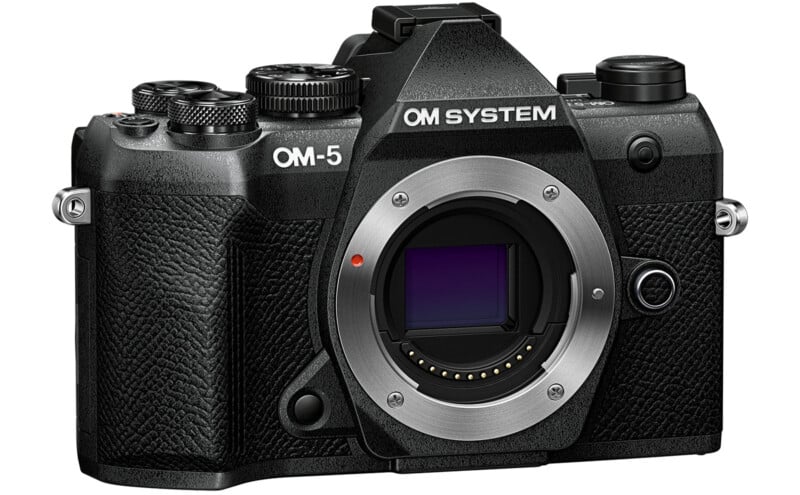The OM System OM-5 Mark II is a ‘Refined’ Compact Travel Camera
![]()
OM System has announced the OM-5 Mark II, which it describes as a “refined” mirrorless interchangeable lens Micro Four Thirds camera built for outdoor enthusiasts.
The company seems to be taking the “if it ain’t broke” mentality to the OM-5, offering some light refreshes to the core of a camera that hasn’t otherwise changed much since it was called the EM-5 Mark III under the Olympus brand. As such, it features a very similar exterior design to that camera and the OM-5 original, albeit with a slightly enlarged grip to make holding the camera easier. It also finally changes the microUSB port to the more versatile USB-C design. The OM-5 now also has a tally lamp.

The company is also leaning more into its computational photography capabilities by adding a “CP” button to the top of the camera to access them more directly (although this button can be reprogrammed). Using that button and the Control Dial in tandem, photographers can quickly access Handheld High Res Shot, Tripod High Res Shot, Live ND (ND2 through ND16), Focus Stacking, HDR, and multiple exposure options.
![]()
On the inside, OM System has upgraded the menu to align with its OM-3 and OM-1 Mark II, which represents a significant improvement in usability. The OM-5 Mark II also integrates the company’s OM-Cinema Video Profiles.
The other selling points of the OM-5 Mark II are familiar. The camera uses the tried-and-true 20.37 megapixel Live MOS sensor powered by OM System’s TruePic IX image processing engine, and focus is delivered via the 121-point all cross-type on-chip phase detection system. Additionally, the OM-5 features the same five-axis image stabilization (for 7.5 stops of stabilization at the center and up to 6.5 at the corners) and remains one of the only interchangeable lens cameras to feature an IP53 rating for splash and dust proofing (most camera companies do not IP rate their cameras at all).
![]()
One other notable change is that the OM-5 Mark II caps out at six frames per second (FPS) with the mechanical shutter, which is the same as the OM-3. This is a downgrade from the original OM-5 which could shoot 10 FPS mechanical, albeit with locked focus — it still capped out at six FPS with full-time autofocus.
![]()
“In previous models, ‘Sequential H (AF fixed)’ was provided as a mechanical sequential shooting mode with fixed AF. However, with the OM-5 Mark II, we have revised the overall structure of the sequential shooting settings to make them more intuitive and less prone to operational errors for a wider range of users,” OM System tells PetaPixel in an email regarding this change.
![]()
“Previously, users could select between ‘Sequential L (AF tracking)’ and ‘Sequential H (AF fixed)’ but based on customer usage and the overall concept of the product, we have streamlined the functionality by removing the ‘AF-fixed mechanical sequential shooting’ mode. If you require high-speed sequential shooting with fixed AF, we recommend using ‘Silent Sequential H,'” OM System continues.
“Compared to the OM-5, the sequential shooting performance of the OM-5 Mark II is equivalent. We will continue improving the balance between usability and functionality, so that customers can enjoy a comfortable and seamless shooting experience.”
Below are a few sample images taken with the OM-5 Mark II, provided by OM System:

![]()




![]()

![]()
![]()

To support the OM-5, OM System has two apps. On mobile, OM Image Share is used to connect to the camera using WiFi and transfer shooting data and perform some remote operations. With the OM-5, this app can be used to update the firmware as well as backup or restore camera settings.
On desktop, the OM Workspace software is an image editor used for RAW processing and editing. “It allows processing settings that can be applied on the camera and editing such as tone curve and dehazing,” OM System explains. “In addition, the AI Noise Reduction function for RAW processing is [available].”
![]()
Pricing and Availability
The OM-5 Mark II is scheduled to be available in early July in black, silver, and a new “sand beige” limited edition option. The body-only will be available for $1,199.99, while a bundle with the M.Zuiko Digital ED 12-45mm f/4 PRO will cost $1,599.99, and a kit with the M.Zuiko Digital ED 14-150mm f/4-5.6 II will be available for $1,499.99. Of note, the new sand beige color is not available in a kit.
Image credits: OM System